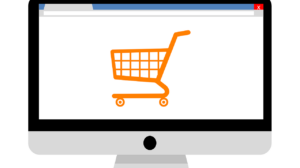Online commerce was a small but actively growing segment. Because of the pandemic, the market has changed dramatically. Online shopping has become a convenient and safe way to shop, which for many has become their No. 1 option
According to Nielsen, online sales accounted for 5% of the total FMCG (Fast-moving consumer goods) market in volume terms. 19% of shoppers have become more frequent online shoppers, and their shopping cart has expanded from impulse categories to everyday goods. For this reason, online retailers are actively expanding their assortment matrix, improving delivery and service conditions to attract the audience to their marketplace. Manufacturers, on the other hand, are trying to attract maximum attention to their product, so as not to get lost among the unopened tabs.
According to Tobii Pro Insight Research Services, 97% of online shoppers typically pay attention to the main product image, 46% pay attention to cross-sell offers, 11% read the specifications, and only 7% read the product description. This tells us that communication should be brief, simple, and focused. Sure thing, depending on specifics of your business you can conduct additional research of the market – or ask professional for research papers help – but these are general rules that apply mostly everywhere. But anyway the choice – to use it or not – is yours.
Going online gives manufacturers new opportunities and limitations to showcase their products. To attract the consumer’s attention, we only have a 250×250 pixel field. It’s not an offline shelf, the height and depth of the packaging don’t matter anymore. There is no tactile interaction with the product. The rules that many brands used to have, have changed completely.
Take up more space in the product card
The larger your product is in relation to the product card, the faster the consumer will notice it. For example, square packaging takes up more space and makes it stand out more. The packaging tends to enlarge the front side and focus on the brand area.
Focus on the brand area and a catchy visual element
The consumer is already used to working with filters. They see the information on weight, composition, and quantity beforehand, or they can read it on the product card. Therefore it is not necessary to try hard to put this information on the package.
Since all packaging is reduced to a 1×1 format, the emphasis is on the front side. It is the front side that should attract the consumer’s attention.
Contrasting backgrounds and competitors
When going online, you should also consider the competitive field – at a minimum, analyze it by color code. It is also important to consider that the packaging should contrast with the background of the product card, in most cases, it will be white. Accordingly, white packaging is not the best solution, as it will blend in with the background and attract less attention.
Similarly, it is worth analyzing competitors – if you break into a monotonous niche with a brightly colored product, it is not difficult to guess who will collect more clicks and, consequently, more purchases.
Color positioning on the online shelf will give an opportunity to fix a certain palette for your brand because it is much easier to be more visible in one palette, rather than surprise the consumer with a variety of colors.
Use no more than four design elements
On the offline shelf, the consumer reads many more elements: title, logo, category, subcategory/properties, country, Unique selling proposition (USP), and volume. Online, the customer pays attention to far fewer elements. Usually, he sees only four items – name, logo, category, and USP.
Use out-of-the-box solutions
You can tell more than others if you approach the matter with a touch of creativity. Here’s an incomplete list of how you can stand out from competitors:
- Show the product from several angles at once.
- Add features that highlight the brand’s strengths to the carousel.
- Show the product itself – together with the package or in a carousel.
- Set yourself apart from the competition by displaying your product off-center, moving it to one side
- Add atmosphere and emotion to the package/product surroundings, if the resource allows it – give a subconscious reason for a customer to buy your product.
Think product first, then packaging
In the age of increased online sales, it’s almost impossible to fool the consumer. If your product is really bad, your audience will know before they put it in their cart. Marketplace communities are gaining momentum and credibility. They are often the ones that help build brand/product images during initial interactions with them. Reviews become a strong marketing tool, no matter how good your design.
How do you show a product and packaging to customers so that they want to buy it?
How do you show a product and packaging to customers so that they want to buy it? There are a few rules for a “tasty” product presentation:
- The resolution and quality of the photo should be as high as possible.
- The more angles, the better; if there is a 360-degree photo, even better.
- Do not overdo it with retouching – if your product will not meet the high expectations of customers (due to an unrealistic presentation), in addition to the fact that the client may not come back to you, he may also leave negative feedback about the product.
- You need to show the way you use it, and in the case of food, the way you serve it. This is how your product is consumed by customers. For example, chocolate is better depicted with a cup of coffee/tea and in cozy colors, and granola in the morning light and bright sunlight. You’re not selling a product, but the feeling, mood, and experience of consuming it.
- A video about the product will be a definite plus. It will add emotion.
To summarize, how do you fend off competitors on the online shelf?
- Take up more space in the product card. Packaging should aim for a square format.
- Make the brand area and logo as large as possible.
- Be sure to add a catchy visual element, such as a large food zone or recognizable mascot.
- Be contrasting to the background and competitors. Occupy your color differentiation on the online shelf.
- Use no more than four design elements. Place emphasis on the logo, name, category, and USP.
- Communicate brand positioning through packaging and visuals – add videos, 360-degree photos, put benefits on the carousel, etc.
- Use non-standard solutions – show the atmosphere and emotions of the product. Sell the feeling, not the product.
- Think about the product first, then the packaging. Maintain communication with consumers, build a dialogue with them.





